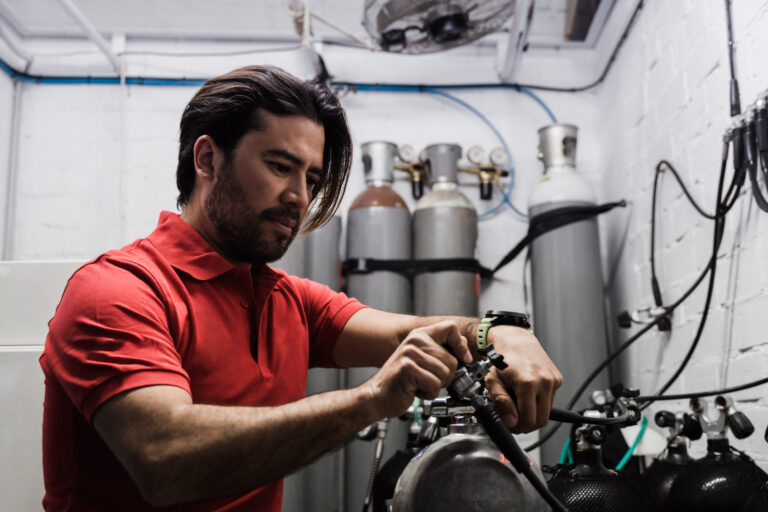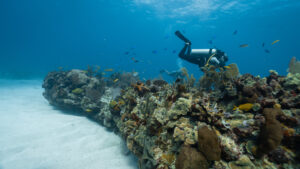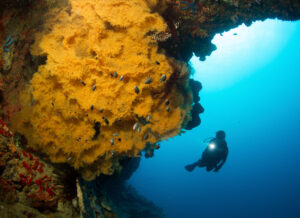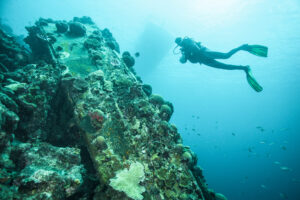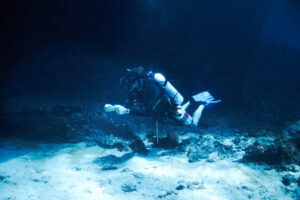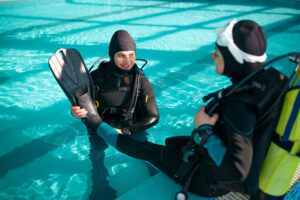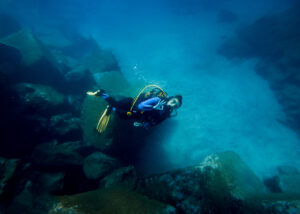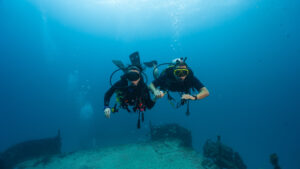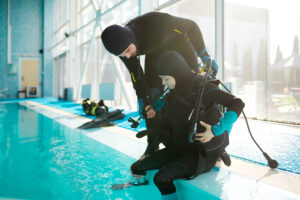What is a Low Pressure Inflator?
The Low Pressure Inflator (LPI) is a crucial component in scuba diving equipment, connecting a diver’s buoyancy control device (BCD) to their air supply. It allows divers to control their buoyancy underwater, making it an essential tool for maintaining stability and comfort during dives. By pressing the inflator button, divers can add air to their BCD, making them more buoyant, while the deflator button allows them to release air, decreasing buoyancy. This control over buoyancy is vital for safe and enjoyable diving experiences.
Historical Development
The concept of controlling buoyancy in water has ancient roots, but the development of the modern LPI began in the mid-20th century. Early divers used makeshift devices to control buoyancy, but these were often unreliable and difficult to use. The advent of the self-contained underwater breathing apparatus (scuba) in the 1940s paved the way for more sophisticated buoyancy control mechanisms.
In the 1950s and 1960s, as recreational diving became more popular, manufacturers began to develop more reliable and user-friendly LPIs. Companies like Aqua-Lung and Scubapro were at the forefront of this innovation, creating the first commercially available LPIs that integrated with early BCDs. These early models were relatively simple, using basic valve systems to control air flow.
As technology advanced, so did the design of LPIs. By the 1980s, LPIs had become more standardized and incorporated into a wider range of BCD designs. The introduction of materials like silicone and high-grade plastics improved the durability and reliability of LPIs. Today, they are a standard feature in all modern BCDs, designed to be easy to use, reliable, and effective in a variety of diving conditions.
Technical Description
The low pressure inflator consists of several key components that work together to manage air flow and buoyancy. At its core is the inflation valve, a mechanism that allows air to flow from the scuba tank into the BCD when the inflator button is pressed. This valve is typically made from durable materials such as stainless steel or high-grade plastic to withstand the harsh underwater environment.
The deflation mechanism is another crucial component. It usually involves a separate button that, when pressed, opens a valve to release air from the BCD. This allows divers to decrease their buoyancy and descend or achieve neutral buoyancy. Some advanced models combine the inflation and deflation mechanisms into a single, multi-functional control unit for easier use.
The LPI is connected to the scuba tank via a low-pressure hose, which is typically made from reinforced rubber or other durable materials. This hose ensures a steady and controlled flow of air from the tank to the LPI. The connection to the BCD is designed to be secure yet easy to attach and detach, often using quick-release fittings or screw-in connectors.
Materials used in the construction of LPIs are chosen for their durability and resistance to corrosion. High-grade plastics, silicone, and stainless steel are common choices, ensuring that the device can withstand the pressures and conditions encountered underwater. The design of the LPI also incorporates ergonomic considerations, with controls positioned for easy access and operation even when wearing gloves.
Operation Mechanism
Using the low pressure inflator is straightforward, but understanding its operation is key to effective buoyancy control. When a diver wants to increase their buoyancy, they press the inflator button. This opens the inflation valve, allowing air from the scuba tank to flow into the BCD. The increase in air volume inside the BCD causes the diver to become more buoyant and rise in the water column.
To decrease buoyancy, the diver presses the deflation button. This action opens the deflation valve, releasing air from the BCD. As the air escapes, the BCD’s volume decreases, making the diver less buoyant and allowing them to descend. Some LPIs have a combined control unit that can both inflate and deflate with different pressures or sequences of button presses, adding convenience and reducing the need for multiple controls.
During a dive, a diver constantly adjusts their buoyancy using the LPI to maintain neutral buoyancy. This means they neither sink nor float, staying at a desired depth with minimal effort. Proper use of the LPI requires practice and familiarity with the equipment, as even small adjustments can significantly affect buoyancy.
Safety mechanisms are built into the LPI to prevent over-inflation, which could lead to uncontrolled ascents. Many LPIs have an overpressure relief valve that automatically releases excess air if the pressure inside the BCD becomes too high. This feature is crucial for preventing accidents and ensuring the diver’s safety.
Maintenance and Care
Regular maintenance and care of the low pressure inflator are essential for ensuring its reliability and longevity. After each use, the LPI should be rinsed thoroughly with fresh water to remove salt, sand, and other debris. This helps prevent corrosion and buildup that can affect the device’s performance.
Periodic inspection of the LPI is recommended to identify any signs of wear or damage. Key areas to check include the inflation and deflation valves, the hose, and the connectors. Any signs of cracking, fraying, or malfunction should be addressed promptly, either through repair or replacement of the affected components.
Lubricating the moving parts of the LPI with appropriate silicone-based lubricants can help maintain smooth operation. However, care should be taken to use only recommended products, as some lubricants can damage the materials used in the LPI.
Storing the LPI properly is also important. It should be kept in a cool, dry place away from direct sunlight and extreme temperatures. When not in use, the LPI should be detached from the scuba tank and BCD, and the hose should be coiled loosely to prevent kinks and stress.
Regular servicing by a qualified technician is recommended, especially before and after extended periods of heavy use. This ensures that all components are functioning correctly and that any potential issues are addressed before they become serious problems.
Safety Considerations
Safety is paramount when using a low pressure inflator. The design of the LPI includes several features to enhance diver safety. One of the primary safety features is the overpressure relief valve, which prevents over-inflation by automatically venting excess air if the pressure inside the BCD exceeds a certain threshold.
Regular inspection and maintenance of the LPI are critical for safety. Any malfunction or damage to the LPI can compromise its performance and the diver’s buoyancy control, potentially leading to dangerous situations. Divers should be familiar with their equipment and perform routine checks before each use to ensure everything is in working order.
Proper training on the use of the LPI is essential. Divers should practice using the inflator and deflator buttons in a controlled environment, such as a pool, before using them in open water. This practice helps build muscle memory and ensures that divers can make quick, accurate adjustments to their buoyancy when needed.
Divers should also be aware of the potential for accidental inflation or deflation. Ensuring that the LPI buttons are not inadvertently pressed while underwater is important, as unexpected changes in buoyancy can be disorienting and dangerous. Keeping the LPI secured and avoiding entanglement with other equipment or the environment helps mitigate this risk.
Using a buddy system and maintaining clear communication with fellow divers can enhance safety. In the event of an LPI malfunction, having a buddy nearby who is familiar with the equipment can provide immediate assistance and help manage the situation.
Variations and Compatibility
The market offers a variety of low pressure inflators, each designed to meet different needs and preferences. Some LPIs are built for simplicity and ease of use, featuring straightforward controls and minimal components. Others are more advanced, with integrated digital displays that provide information on air pressure and buoyancy levels.
Compatibility with different BCDs and air sources is an important consideration when choosing an LPI. Most modern LPIs are designed to be universally compatible, but divers should verify that their chosen model works with their specific equipment. Manufacturers often provide compatibility information, and consulting with a dive equipment specialist can help ensure a proper match.
Selecting the right LPI depends on factors such as the type of diving, personal preferences, and budget. Recreational divers may prefer simpler, more affordable models, while technical divers might opt for advanced LPIs with additional features. Regardless of the choice, ensuring that the LPI is reliable, easy to use, and well-maintained is crucial for a safe and enjoyable diving experience.
Key Takeaways
The low pressure inflator is a vital component in scuba diving, allowing divers to control their buoyancy and maintain stability underwater. Proper use, maintenance, and understanding of the LPI are essential for safe and effective diving. With various models available, divers can choose an LPI that best suits their needs, ensuring a reliable and enjoyable experience in the water.

